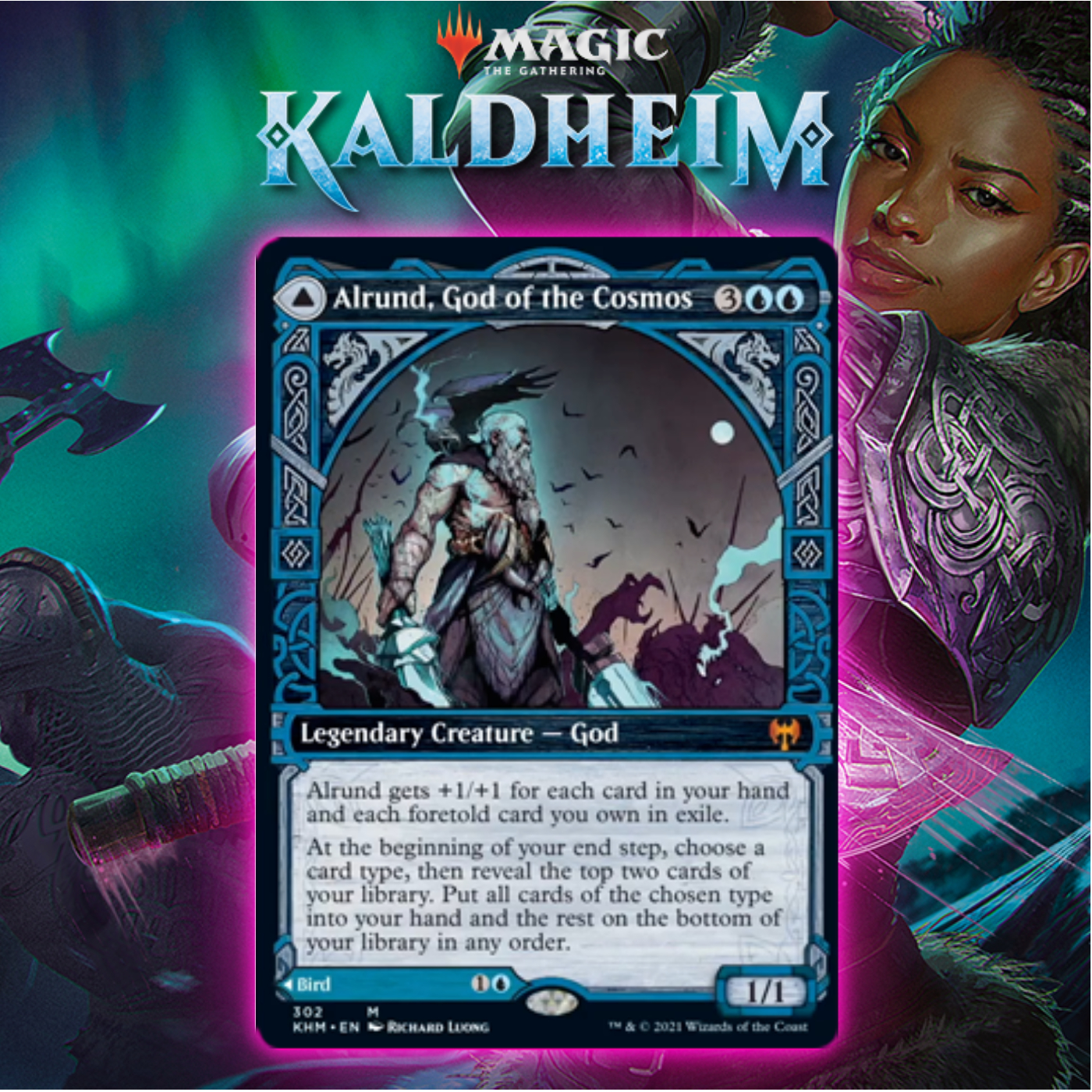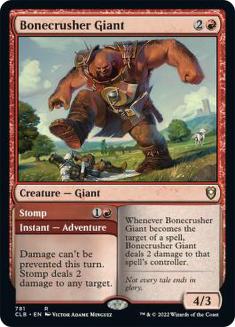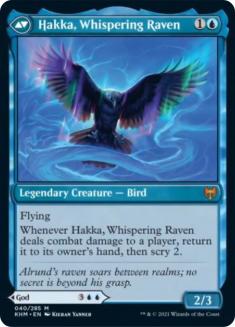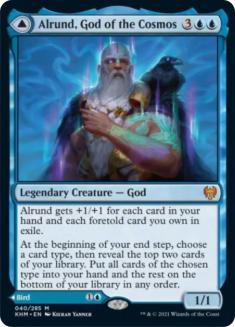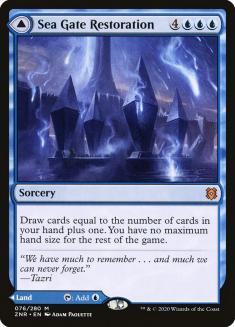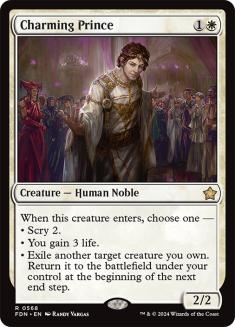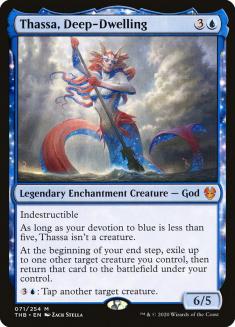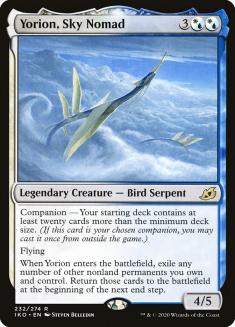If you’ve followed my content in the past year or so, you know I value flexibility a lot. Cards that are good in many different situations of the game and can do different things depending on whether you’re ahead or behind are usually my favorite. When Throne of Eldraine came around, for example, the card I chose to highlight was Bonecrusher Giant.
Alrund, God of the Cosmos isn’t that similar to Bonecrusher Giant, but it does have a similar style of flexibility that draws my eye and makes me think it’s worth exploring. At first glance, Alrund is a modal spell — you can either get a two-drop creature or a five-mana finisher. So, let’s see how each mode fares:
Hakka, Whispering Raven is a defensive-oriented two-drop. As a blocker, it stops some of the most-played early attackers – Robber of the Rich, Heart’s Desire Human tokens, any creature from Mono-White Aggro, Fervent Champion, etc. – but not all, as Brushfire Elemental and all the three-drops bypass it. It’s also immune to the most common burn spell in the format, Stomp.
As an attacker, it’s not going to be the best at dealing your opponent damage, but it has some other uses. The way it’s worded means it can pressure planeswalkers freely, and it can help you find a fourth land or a four-drop to cast. If you have free mana, then it’s actually quite strong, as you get to attack, scry, and recast it, which gives it pseudo-vigilance on top of scrying.
Unlike its Bird counterpart, Alrund, God of the Cosmos is not exactly a unique card — Syr Elenora, the Discerning, for example, is still Standard-legal and is not so different from it. The difference, of course, is that Alrund will continue to draw cards if it lives, so it can actually take over the game by itself. I would likely not play this card if this was the only side, but the fact that you can choose to play it as a two-drop early on or as a Maro / Honden of Seeing Winds combination adds an entirely new dimension to it, as the big blocker gives you time to generate value from the second ability.
Speaking of the second ability, how good is it? I would say that, in general, it’s going to be worse than drawing a card, but it has outs to be better. If your deck is 50% one card type, your EV is the same as drawing a card. Most decks don’t have 50% of one card type, but you could in theory have a deck that is more than 50% creatures, in which case you’re getting better odds here. You can also manipulate your deck in some ways, such as by scrying, and you can dig deeper if you’re looking for a specific card. In the late-game, for example, it might be much more interesting to have two shots at an instant or sorcery than to draw a card from a deck that is 40% land.
In this regard, modal DFCs like Shatterskull Smashing and Sea Gate Restoration can be a blessing or a curse — if you are specifically looking for card quantity, they make it less likely you’re going to hit, as “land” is going to be your most-named card (for example, if you just need to grow your Alrund to a certain size to be able to block), but later in the game you’re never going to be naming land so they offer you more chances to hit something meaningful if you’re naming sorcery (or creature in the case of Kazandu Mammoth, etc.).
It’s also worth noting that, even though you’ll mostly get to use this ability (since it works at the end of the turn), sometimes they will kill it before the turn ends and you’ll get nothing — in this regard, it’s obviously weaker than it would be as an enter-the-battlefield trigger.
So, as a regular DFC, I’d say that Alrund is at least interesting. It’s a finisher that offers early-game defensive capabilities (as well as potentially filtering and planeswalker-pressuring), and it also bypasses its legendary status in some ways since it’s two cards with two different names, so you can just play four copies without worrying too much. To me, this versatility already makes it worth exploring.
The thing is, Alrund is not your regular double-faced card because, when you cast Hakka, Whispering Raven, you also get an Alrund later on. In this regard, it’s very similar to an Adventure card; with Bonecrusher Giant, you’re choosing between Bonecrusher Giant now or Stomp now and Bonecrusher Giant later. With Alrund, it’s the same — you’re choosing between Alrund now or Hakka now and Alrund later. You don’t get to kill a creature, but you do get to deal damage, scry, and save a lot of life, and these effects are all permanent, even if the Bird itself is not on the battlefield anymore.
The key is, of course, that when you return Hakka to your hand, you then have a choice to cast it as Alrund. This means that your five-mana finisher/card advantage machine comes with a built-in defensive tool that also helps digging for your fifth land without you having to spend it. You might look at Hakka and think, “I don’t want to pay two mana to scry 2,” and normally you’d be right, but you have to also take into account that you’re not actually spending a card for that — it’s just an ability that your five-drop happens to have while it’s in your hand.
On top of it all, the scry 2 ability from Hakka works very well with the card-drawing ability from Alrund, ensuring that, at least for the first turn, you get to draw a card for sure if you’re interested in that, and making it much easier to get to draw two cards. If you draw two cards the turn you cast this, it’s the world’s best Mulldrifter and actually a better play than a Hydroid Krasis for four most of the time, even though it only costs five. All in all, I have to say that, regardless of power level, this is one of my favorite cards in recent memory — it’s just in this small little bubble where it does everything by itself. Besides that, the flavor is A+.
There’s yet another dimension to Alrund in that, contrary to our expectation (or at least contrary to my expectation, I don’t know about you), the “bigger” side is the front side. In general, when I see a double-faced card, I always expect the smaller side to be in the front, but this isn’t the case here. This means that, if you ever blink Hakka, you’re getting an Alrund in return, which means it’s something actually worth doing. Right now, Standard is full of blink cards — Charming Prince; Thassa, Deep-Dwelling; and Yorion, Sky Nomad, to name a few.
You’re still not getting this online much sooner than you otherwise would (since the triggers only work at the end of the turn for these cards, which means you have to wait an extra turn for the Alrund trigger), but turning your two-drop into a five-drop en passant as you cast your Yorion is definitely a plus.
So, where would you play Alrund, God of the Cosmos? Honestly, I’m not sure. There’s no deck right now where I think this would be a slam dunk, but I do think it’s fair game for basically any of the blue decks that exist, especially the ones that can blink it for a bonus. I think that Dimir Control with Yorion, for example, could be a natural home for it, as it can use all parts of it — the early blocker, the scrying, and the finisher. Here’s an attempt:
Creatures (4)
Planeswalkers (2)
Lands (32)
Spells (42)

On top of Alrund, we also get to play Behold the Multiverse as an upgrade (at least in my opinion) to Rain of Revelation. I also like that this deck is playing Mazemind Tome, which also lets you control your Alrund triggers to an extent.
In the end, Alrund is different from anything we’ve ever had — Hakka alone is already hard to evaluate and that’s only half the card! Because of this, I don’t know for sure if the right deck for it currently exists in Standard — I’m going to try it in decks like this Dimir Control with Yorion and I’m even going to try it in Dimir Rogues, but it’s not a slam dunk and there’s a chance that it doesn’t belong in them. However, even if that ends up being the case, this doesn’t mean it’s not a good card — Dimir Rogues has a clear strategy and Alrund isn’t adding to that, for example, so it’s less about its power level and more about Rogues as a deck and the format we’re currently playing.
Even if Alrund turns out not to be good in the decks that currently exist, I think it’s a strong enough card that we should definitely keep it in mind. There’s a lot more of Kaldheim to come and many new decks can potentially emerge, and it’ll be legal in Standard for two years still. Right now it might not be good enough because it doesn’t block Brushfire Elemental, but what happens when the premier aggro deck is Rakdos or Boros? At this point a 2/3 flyer for two mana might be a premium blocker, and all of a sudden Hakka is great. The new Pathways alone might change the format enough that several new decks show up, and once they do, Alrund could become an all-star.
So yeah, I don’t know for sure if it’s good enough, but it’s so different, intriguing, and potentially powerful that I’ll surely try it out wherever I can.

